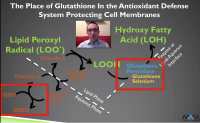L
lollipop
Guest
+1Obi-wan, your the man!... I follow you...I know you have serious health issues and I wish you well.
Follow along with the video below to see how to install our site as a web app on your home screen.
Note: This feature may not be available in some browsers.
Click Here if you want to upgrade your account
If you were able to post but cannot do so now, send an email to admin at raypeatforum dot com and include your username and we will fix that right up for you.
+1Obi-wan, your the man!... I follow you...I know you have serious health issues and I wish you well.
I think mixed tocopherols in olive would be the best. The 'mixed tocopherols' have all of the Greek subtypes—α, β, γ, and δ—which are all slightly different. Gamma‐(γ)‐tocopherol is unique in that it can capture reactive nitrogen species (RNS) on the cell membrane, something that α‐tocopherol cannot do. Alpha‐(α)‐tocopherol can actually displace γ‐tocopherol leading to a lower rate of RNS clearance. Like many things dealing will small free radicals, the ability of γ‐tocopherol to capture RNS has actually been demonstrated (by serious chemists, multiple times):@Travis, would really like to get your thoughts on wheat germ oil since it seems to be high in linoleic acid and many of us use it for a Vit. E supplement.
Actually better to use transdermal. Stearic acid will stay as stearic acid where if taken orally some will convert to oleic acidI have a cocoa butter/shea oil combo I've been putting on scar tissue. Maybe I should be eating it . . .
So , a cream with pure stearic acid might be a good solution.Actually better to use transdermal.
I would think so as long as it does not include a vegetable oilSo , a cream with pure stearic acid might be a good solution.
@Travis I don't understand how Vit. E can be protective against PUFA when it comes from PUFA?

If you look at the eicosanoids, you'll see that they are all oxidized 20‐carbon polyunsaturated fatty acids. Some of the simpler ones, like leukotriene B₄, are so simple that they can be made spontaneously from O₂ on the cell membrane. However, this would still have to be cleaved off the phospholipid for it to signal the nucleus. I have even read an article where a cyclic 'prostaglandin‐like' eicosanoid had been formed spontaneously from oxygen—a truly bizarre lipid.
Kiwi fruits! They have plenty of vitamin E, C and K.In general, food sources with the highest concentrations of vitamin E are vegetable oils, followed by nuts and seeds including whole grains. Adjusting for typical portion sizes, however, for many people in the United States the most important sources of vitamin E include commercial breakfast cereal and tomato sauce.[22] Although originally extracted from wheat germ oil, most natural vitamin E supplements are now derived from vegetable oils, usually soybean oil.
Vitamin E content per 100 g of source include:[23][24]